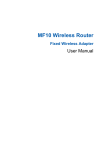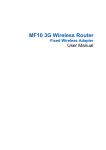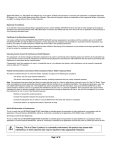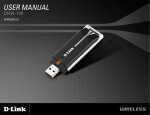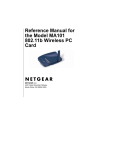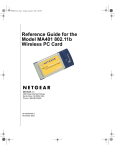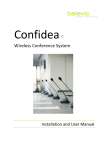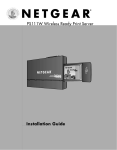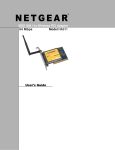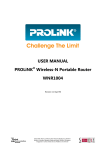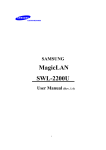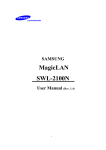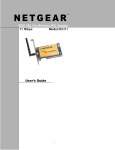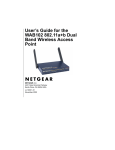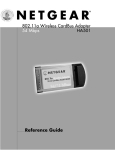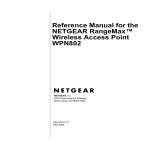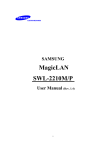Download HA501 User Manual
Transcript
NETGEAR ® IEEE 802.11b Wireless CF Card 11 Mbps MA701 User’s Guide . NETGEAR, INC. 4500 Great America Parkway Santa Clara, CA 95054 USA Phone: 1-888-NETGEAR E-mail: [email protected] www.NETGEAR.com Technical Support YOU MUST REGISTER TO OBTAIN TECHNICAL SUPPORT. PLEASE RETAIN PROOF OF PURCHASE AND THE WARRANTY INFORMATION. To register your product, get product support or obtain product information and product documentation, go to http://www.NETGEAR.com/register. You’ll find technical support information at http://www.NETGEAR.com/ through the Customer Service area. If you want to contact technical support by telephone, see the support information card for the correct telephone number for your country. © 2002 by NETGEAR, Inc. All rights reserved. NETGEAR is a trademark or registered trademark of NETGEAR, Inc. in the United States and/or other countries. Other brand and product names are trademarks or registered trademarks of their respective holders. Information is subject to change without notice. CONTENTS CHAPTER 1—INTRODUCTION ........................................................................................................3 Features.........................................................................................................................................4 Package Contents..........................................................................................................................4 About This Guide ...........................................................................................................................5 Ready, Set, Go! .............................................................................................................................5 CHAPTER 2—INSTALLATION .........................................................................................................6 System Requirements....................................................................................................................6 Step 1—Preparation ......................................................................................................................7 Step 2—Install the MA701 Driver and Utility..................................................................................7 Step 3—Insert the MA701 Wireless CF Card ................................................................................9 Step 4—Configure the Network Settings .....................................................................................10 Step 5—Test For Wireless Access ..............................................................................................13 CHAPTER 3—CONFIGURING THE MA701 WIRELESS CF CARD ..............................................15 Status Property Page...................................................................................................................16 Configuration Property Page........................................................................................................19 Security Property Page ................................................................................................................22 Ping Property Page......................................................................................................................24 Performance Property Page ........................................................................................................25 AP Browser Property Page ..........................................................................................................26 About Property Page....................................................................................................................27 CHAPTER 4—WIRELESS NETWORK FUNDAMENTALS ............................................................28 Wireless Network Configuration...................................................................................................28 Ad-hoc Mode (Peer-to-Peer Workgroup)................................................................................28 Infrastructure Mode.................................................................................................................29 Service Set Identification (SSID)..................................................................................................30 Authentication and WEP Encryption............................................................................................30 Wireless Channel Selection .........................................................................................................32 APPENDIX A—TROUBLESHOOTING............................................................................................33 APPENDIX B—GENERAL SPECIFICATIONS ...............................................................................34 APPENDIX C—REGULATORY COMPLIANCE..............................................................................35 2 CHAPTER 1—INTRODUCTION Thank you for purchasing NETGEAR’s IEEE 802.11b Wireless Compact Flash Type I Card, Model MA701. With this new Wireless Compact Flash Card, your Handheld PC (Windows CE 2.11 or above) and Pocket PC (Windows CE 3.0) can take advantage of wireless access to your corporate LAN, surf the Internet, access e-mails, and communicate with other mobile devices enabled for IEEE 802.11b standard-based wireless LAN connectivity. MA701 Wireless Compact Flash Card 3 Features The key features of the IEEE 802.11b Wireless Compact Flash Card, Model MA701 are: ♦ Reliable IEEE 802.11b standards-based wireless technology designed for multi-vendor compatibility. ♦ Fast data transfer speeds up to 11 Mbps. ♦ Easy installation on all Pocket PCs and Handheld PCs with Compact Flash Type I or Type II card slots. ♦ Supports multiple data rates, including 1, 2, 5.5 and 11 Mbps, with an auto fallback feature to ensure dependable connectivity. ♦ Built-in privacy protection supports both 40/64 and 128-bit WEP (Wired Equivalent Privacy) encryption systems. ♦ Offers a wireless range up to 300 feet in an office environment. Package Contents This product package should contain: ♦ IEEE 802.11b 11 Mbps Wireless Compact Flash Card, Model MA701 ♦ CD-ROM with Driver and Utility Installation Wizard ♦ This User’s Guide ♦ Warranty and Registration Cards ♦ Support Information Card 4 About This Guide This User’s Guide will show you how to install and use NETGEAR’s Wireless Compact Flash Card, Model MA701. With a few simple steps, you can connect your Windows CE-based PDA via the 802.11b Wi-Fi certified Access Point (AP) into an existing network for secure Internet access. Throughout this guide, only Pocket PC screen shots are displayed. Handheld PC 2000 and Handheld PC Pro screens will be functionally equivalent. Ready, Set, Go! The Wireless Compact Flash Card, Model MA701 is easy to install. You need only to complete these five steps, which should take about 10 to 15 minutes: Preparation. Install the MA701 Driver and Utility software. Insert the MA701 Wireless CF Card. Configure the network settings. Test for wireless access. To start the installation process, turn to page 6, Chapter 2—Installation. 5 CHAPTER 2—INSTALLATION This chapter provides step-by-step instructions to install the IEEE 802.11b Wireless Compact Flash Card, Model MA701. System Requirements Before installing the MA701 Wireless CF Card, please make sure that these requirements have been met: ♦ You must have a Pocket PC 2000/2002 (P/PC), or Handheld PC (H/PC) with a Compact Flash Type I or II slot. ♦ The Windows CE version should be V2.11 or higher. ♦ There should be at least 500 Kbytes of free memory on your P/PC or H/PC. ♦ You must have a Desktop PC or Laptop PC with Microsoft ActiveSync software successfully installed. This PC will be used for installing the MA701 Driver and Utility software to your Pocket PC or Handheld PC. 6 Step 1—Preparation Before beginning the installation, please perform these steps: 1. Verify the package contains a MA701 Wireless CF Card and a MA701 Driver and Utility Installation Wizard CD. 2. Make sure your Pocket PC or Handheld PC is equipped with a Compact Flash Type I or II slot. 3. Make sure your target Pocket PC or Handheld PC has at least 500 Kbytes free memory for the MA701 Driver and Configuration Utility. 4. Establish a connection between the host PC and your PDA using Microsoft ActiveSync software. Step 2—Install the MA701 Driver and Utility To install the MA701 Wireless CF Card Driver and Utility software, follow these steps: 1. Make sure you have an ActiveSync connection between the host PC and your Pocket PC or Handheld PC with a serial or USB cable. 2. Make an active partnership between your Pocket PC or Handheld PC and the host PC. 3. On the host PC, insert the MA701 Driver and Utility CD into the CDROM drive. 7 4. On the host PC, double-click My Computer, then double-click the CDROM drive where the MA701 Driver and Utility CD is located. 5. Double-click the Pocket PC or Handheld PC file folder. 6. Double-click SETUP.EXE to launch the installation wizard and follow the instructions displayed on the screen. 7. Click Yes to install the utility using the default application installation directory. 8. Click the Finish button to complete the installation. 9. Disconnect your Pocket PC or Handheld PC from the host PC. 10. Press the reset button on your Pocket PC or Handheld PC. Upon successful installation of the MA701 Driver and Utility software, a MA701 icon will be created under Programs on your Pocket PC or Handheld PC. Tap this icon to start the MA701 Configuration Utility. 8 Step 3—Insert the MA701 Wireless CF Card ♦ Insert the MA701 Wireless CF Card directly into the Compact Flash I/O slot. After your Pocket PC or Handheld PC recognizes the MA701 and initializes it, the Link LED will either flash green or remain a solid green (for more details, see the following note). Proceed to Step 4 to enter the network settings. A Note About the LED Indicator The MA701 Wireless CF Card has a status Link LED with these settings: LED STATUS DESCRIPTION Off No Power Solid Green Indicates: 1. Associated with the Access Point, or 2. Connected to an Ad-hoc wireless device. Flashing Green Indicates: 1. Not connected to the Access Point, or 2. Power Save Mode is enabled. 3. Connected to a 802.11 Ad-hoc network. 9 Step 4—Configure the Network Settings This step configures your Pocket PC or Handheld PC with the MA701 Wireless CF Card in Windows CE. Note: For detailed information on wireless networking, refer to Chapter 4— Wireless Network Fundamentals, page 28. 1. Select Settings and then tap the Network Adapters option. 2. Select the NETGEAR MA701 Wireless CF Card entry. 10 3. Tap the Properties button to open the IP Settings page. 4. Enter the appropriate IP address information for the MA701 Wireless CF card and then tap OK. Note: If you are unsure of the IP related information, please contact your network administrator or MIS staff personnel. 5. Tap the MA701 icon from Programs and open the MA701Configuration Utility. It will automatically open the Status page to display the current Link status, as shown on the next page. 11 6. Use the Status, Configuration, Security, Ping, Performance, AP Browser, and About tabs to view or adjust the MA701 Wireless CF Card configuration settings. The default settings are: ♦ SSID: ANY ♦ Mode: Infrastructure ♦ Encryption (WEP): Disabled 7. Tap Apply to save your configuration settings. 8. Tap OK on upper right-hand corner to close the MA701 Configuration Utility status screen. 12 Note: For additional information on using the MA701 Configuration Utility, please refer to Chapter 3—Configuring the MA701 Wireless CF Card on page 15. Step 5—Test For Wireless Access Follow these steps to verify that the MA701 Wireless CF Card has been successfully installed and that your wireless access is functioning properly. 1. Open the MA701 Configuration Utility and tap IP Status from the Status page to view IP related information (shown below). A valid IP address should be assigned for the MA701 Wireless CF Card. 2. Tap OK in the IP Status page to close it. 13 3. Tap the Ping option to test the data transmission between your Pocket PC or Handheld PC and other computers, such as the host PC. 4. Enter the IP address of the other PC or the device you need to Ping to, and then tap Start to begin the test. 5. If the Ping test is successful, it will display the reply information in the list box. Once this occurs, your Pocket PC or Handheld PC will have the correct wireless connection settings to access the net. 14 CHAPTER 3—CONFIGURING THE MA701 WIRELESS CF CARD Now that you have successfully installed the MA701 Wireless CF Card, you can use the MA701 Configuration Utility to view and customize configuration settings and features. The MA701 Configuration Utility contains seven Property Pages: 1 - Status 2 - Configuration 3 - Security 4 - Ping 5 - Performance 6 - AP Browser 7 - About Note: The above Property Pages are always available from the bottom of the MA701 Configuration Utility window. This utility provides you with wireless network and link quality information for the MA701 Wireless CF Card. The Configuration Utility includes two useful utilities—Ping and AP Browser. Use these if you need help with troubleshooting any wireless connection-related issues that may arise. 15 Status Property Page The Status page of the MA701 Configuration Utility displays the current condition of your wireless LAN, and is the default page that will be displayed: . To see a detailed description of the IP Status page options, please refer to the table on the next page. 16 This table describes the Status page of the MA701 Configuration Utility. STATUS DESCRIPTION Connected to This field displays the association of the access point (SSID) or other wireless nodes in Ad-hoc mode. AP MAC Addr (BSSID) Shows the MAC address of the associated access point (AP) when the MA701 Wireless CF Card is configured in infrastructure mode, or the BSSID if it is configured in Ad-hoc mode and 802.11 Ad-hoc mode. Mode Channel Link Rate Encryption IP Status Indicates the current Network mode used -- 802.11 Ad-hoc mode, Ad-hoc mode, or Infrastructure mode. The default value for Network mode is Infrastructure. • 802.11 Ad-hoc mode: The wireless nodes form their own local network where the end nodes communicate peer-to-peer without an access point. • Ad-hoc mode: Similar to 802.11 Ad-hoc but with less restriction. • Infrastructure mode: The wireless node searches all available wireless channels to associate with an access point. Shows the current channel in use. Shows the current transmit data rate of the wireless node. The possible link rates are 1, 2, 5.5, and 11 Mbps. In Ad-hoc mode, this field shows what the wireless node is configured to use. When in Infrastructure mode, it shows the result of the transfer rate negotiated between the access point and the wireless node. This field indicates if the WEP encryption is enabled or disabled. This button will display the IP Address information related to the MA701 Wireless CF Card: IP Address, Subnet Mask, the Default Gateway, DHCP Server, and the MAC Address. 17 From the Status page, tap IP Status to display this page: When you have finished making any changes, tap the OK button from the IP Status page to continue. 18 Configuration Property Page The Configuration page of the MA701 Configuration Utility lets you change the current network settings related to the MA701 Wireless CF Card. From this page, you can configure various wireless LAN parameters. Please refer to the chart on the following table for specific details. When you have finished making your changes, tap Apply. If you have made changes but do not want to save them, you can tap Defaults to return them to the manufacturer’s default settings. 19 The table, shown below and continued on the next page, describes the Configuration page of the MA701 Configuration Utility. CONFIG SETTINGS DESCRIPTION Network Mode Indicates the current Network mode configured, as listed below. • 802.11 Ad-hoc mode—The wireless nodes form their own local network where the end nodes communicate peer-to-peer without an access point. The same SSID and Channel are required for 802.11 Ad-hoc mode. • Ad-hoc mode—Similar to 802.11 Ad-hoc but only needs to set the same Channel. • Infrastructure mode—The wireless node searches all available wireless channels to associate with an access point. Default: Infrastructure Network SSID (Service Set ID) Enter a 32-character (maximum) service set ID in this field; the characters are case sensitive. When in Infrastructure mode, this field defines the service set ID (SSID). The SSID assigned to the wireless node is required to match the access point SSID in order for the wireless node to communicate with the access point. Default: ANY Link Rate This field shows the current transmit data rate of the wireless node. The possible link rate selections are 1, 2, 5.5, or 11 Mbps and Fully Auto. In Ad-hoc mode, this field shows what the wireless node is configured to use. When in Infrastructure mode, it shows the result of the transfer rate negotiated between the access point and the wireless node. Default: Fully Auto Channel Shows the current channel and frequency in use. The wireless channel in use will be between 1 to 11 for US and Canada, and 1 to 13 for Europe and Australia. Power Management Enables the MA701 Wireless CF Card to enter sleep mode to conserve battery power. Default: Off 20 CONFIG SETTINGS DESCRIPTION Fragmentation Threshold This is the packet length used for fragmentation. Packets larger than the size programmed in this field will be fragmented. The Fragment Threshold value must be larger than the RTS Threshold value. Default: 2346 RTS Threshold The packet size that the wireless node uses to determine if it should use the CSMA/CD mechanism or the CSMA/CA mechanism for packet transmission. With the CSMA/CD transmission mechanism, the transmitting station sends out the actual packet as soon as it has waited for the silence period. With the CSMA/CA transmission mechanism, the transmitting station sends out an RTS packet to the receiving station, and waits for the receiving station to send back a CTS packet before sending the actual packet data. Default: 2342 Preamble Type A long transmit preamble allows the receiver to lock into the received bit patterns more easily. A short transmit preamble provides better performance. Default: Long Defaults Apply Tap Defaults to restore to default settings. Tap Apply to save and make any changes take effect. 21 Security Property Page The Security page of the MA701 Configuration Utility allows you to enable the WEP (Wired Equivalent Privacy) for secure wireless data transmission. Please refer to Chapter 4—Wireless Network Fundamentals on page 28 for details. The 64-bit or 128-bit WEP keys can be generated from a user-defined Passphrase by selecting the Create with Passphrase option, or entered manually by selecting Manual Entry. Click Apply to save changes or Undo to not save changes. 22 This table shows the Security parameters of the MA701 Configuration Utility. SECURITY Encryption (WEP) Passphrase DESCRIPTION The MA701 Wireless CF Card supports 64 or 128-bit WEP data encryption. (64-bit WEP data encryption is also called 40-bit WEP data encryption by some vendors.) This parameter enables/disables encryption and selects the 64 or 128-bit WEP data encryption key to use. You need to enter 10-digit hexadecimal values for 64-bit encryption or 26 digit hexadecimal values for 128-bit encryption. Default: Disabled The Passphrase can be a text string with a maximum of 31 alpha-numeric characters. Key 1 One of the data encryption keys defined in the MA701 Wireless CF Card. Each data encryption key contains 10/26 hexadecimal numbers, making it 40/104 bits wide. This combined with the twenty-four factoryset bits, makes up a 64/128-bit encryption key. Note: Only Key 1 is available for 128-bit encryption. Key 2 One of the four 64-bit data encryption keys defined in the MA701 Wireless CF Card. Key 3 One of the four 64-bit data encryption keys defined in the MA701 Wireless CF Card. Key 4 One of the four 64-bit data encryption keys defined in the MA701 Wireless CF Card. 23 Ping Property Page The Ping page of the MA701 Configuration Utility lets you perform a data transmission test to evaluate if your wireless access connections are working properly. The data transmission test sends an ICMP ping packet across the network to a pre-configured address to test data transmission between the MA701 Wireless CF Card and other network nodes. Use the Host field to enter the IP address or Web address of the target device (i.e.: 10.1.1.122). You may also choose different size ICMP packets, as well as choose to run a continuous test or a test for the specified count. 24 Tap Start to perform the ping test. The round-trip time that each ICMP ping takes to complete the test will be displayed. The minimum, maximum and average round-trip time are displayed in the Statistics section. Tap Stop to end the ping test. Performance Property Page The Performance page of the MA701 Configuration Utility displays a real-time graph of the radio signal transmission strength and the link quality from the MA701 Wireless CF Card to the associated Access Point. It also periodically updates the throughput of the transmitted and received packets. 25 AP Browser Property Page The AP Browser page of the MA701 Configuration Utility displays a list of the Access Points that have been detected by the MA701 Wireless CF Card. The SSID, MAC Address, Channel in use, Signal Strength, WEP information will be displayed. Tap Rescan to update the list of known Access Points. Note: This page is only applied while in Infrastructure mode. 26 About Property Page The About page of the MA701 Configuration Utility displays the Driver, Firmware, Configuration Versions, and the Regulatory Domain of the MA701 Wireless CF Card. 27 CHAPTER 4—WIRELESS NETWORK FUNDAMENTALS Wireless Network Configuration Ad-hoc Mode (Peer-to-Peer Workgroup) The Institute of Electrical and Electronics Engineers (IEEE) standard for wireless LANs (WLANs), 802.11, offers two methods for configuring a wireless network — Ad-hoc and infrastructure. In an Ad-hoc network, computers are brought together as needed; thus, there is no structure or fixed points to the network — each node can generally communicate with any other node. There is no access point involved in this configuration. It enables you to quickly set up a small wireless workgroup and allows workgroup members to exchange data or share printers as supported by Microsoft Networking in the various Windows operating systems. Some vendors also refer to Ad-hoc networking as Peer-toPeer workgroup networking. In this configuration, network packets are directly sent and received by the intended transmitting and receiving stations. As long as the stations are within range of one another, this is the easiest and least expansive way to set up a wireless network. To set up an Ad-hoc workgroup operating with standard protocols, do the following: ♦ Set all stations to connect in Ad-hoc mode (or Peer-to-Peer workgroup mode). ♦ Set all stations to use the same network name (or SSID). 28 ♦ Set all stations to use no WEP encryption key or an identical WEP encryption key. ♦ Set all stations to use the same wireless channel for communication. Infrastructure Mode With a wireless access point, you can put the wireless LAN into the infrastructure mode. It provides wireless connectivity to multiple wireless network devices within a fixed range or area of coverage, interacting with a wireless node via an antenna. In the infrastructure mode, the wireless access point converts airwave data into wired Ethernet data, acting as a bridge between the wired LAN and wireless clients. Connecting multiple ME102 Access Points via a wired Ethernet backbone can further extend the wireless network coverage. As a mobile computing device moves out of the range of one access point, it moves into the range of another. As a result, wireless clients can freely roam from one Access Point domain to another and still maintain seamless network connection. To set up an infrastructure network operating with standard protocols, do the following: ♦ Set all wireless stations to connect in infrastructure mode ♦ Set all stations to use the same network name (or SSID). ♦ Set all wireless access point to use the same network name (or ESSID). ♦ Set all stations to use no WEP encryption key or an identical WEP encryption key. ♦ Set up wireless channels used by individual access point. (It is not necessary to set channels on the stations as the stations will automatically scan through all channels for the nearest access point.) 29 Service Set Identification (SSID) The Service Set Identification (SSID) is a thirty-two alphanumeric character (maximum) string identifying the wireless local area network. Some vendors refer to the SS ID as network name. For stations to communicate with each other, all stations must be configured with the same SSID. A wireless LAN consisting of nodes operating in Ad-hoc configuration without an access point is called a Basic Service Set (BSS). All nodes in a BSS must use the same Basic Service Set ID (BSSID). In an infrastructure configuration with access points, multiple BSS can be configured to form an Extended Service Set (ESS). In this configuration, the access points are configured with the same Extended Service Set ID (ESSID). Wireless clients configured with the same ESSID can freely roam from one Access Point domain to another and still maintain seamless connection to the network Authentication and WEP Encryption The absence of a physical connection between nodes makes the wireless links vulnerable to information theft. To provide certain level of security, IEEE 802.11 standard has defined two types of authentication methods, Open System and Shared Key. Open System authentication is a null algorithm. Shared Key authentication is an algorithm where both the transmitting node and the receiving node share an authentication key to perform a checksum on the original message. By default, IEEE 802.11 wireless devices operate in an open system network. 30 Wired Equivalent Privacy (WEP) data encryption is utilized when the wireless nodes or access points are configured to operate in Shared Key authentication mode. There are two shared key methods implemented in most commercially available products, forty-bit WEP data encryption and 128-bit WEP data encryption. The forty-bit WEP data encryption method, allows for a five-character (forty-bit) input. Additionally, 24 factory-set bits are added to the forty-bit input to generate a 64-bit encryption key. (The 24 factory-set bits are not user configurable.) This encryption key will be used to encrypt/decrypt all data transmitted via the wireless interface. Some vendors may refer to the forty-bit WEP data encryption as 64-bit WEP data encryption since the actual encryption key used in the encryption process is 64 bits wide. The 128-bit WEP data encryption method consists of 104 configurable bits. Similar to the forty-bit WEP data encryption method, the remaining 24 bits are factory set and not user configurable. Some vendors allow passphrases to be entered instead of the cryptic hexadecimal characters to ease encryption key entry. Encryption Key Size 64-bit (24+40) 128-bit (24+104) # of Hexadecimal Digits Example of Hexadecimal Key Content 10 4C72F08AE1 26 4C72F08AE19D57A3FF6B260037 31 Wireless Channel Selection IEEE 802.11 wireless nodes communicate with each other using radio frequency signals in the ISM (Industrial, Scientific, and Medical) band between 2.4Ghz and 2.5Ghz. Neighboring channels are 5Mhz apart. However, due to spread spectrum effect of the signals, a node sending signals using a particular channel will utilize frequency spectrum12.5Mhz above and below the center channel frequency. As a result, two separate wireless networks using neighboring channels (for example, channel 1 and channel 2) in the same general vicinity will interfere with each other. Applying two channels that allow the maximum channel separation will decrease the amount of channel cross talk, and provide a noticeable performance increase over networks with minimal channel separation. Channel Center Frequency Frequency Spread 1 2412Mhz 2399.5Mhz – 2424.5Mhz 2 2417Mhz 2404.5Mhz – 2429.5Mhz 3 2422Mhz 2409.5Mhz –2434.5Mhz 4 2427Mhz 2414.5Mhz –2439.5Mhz 5 2432Mhz 2419.5Mhz – 2444.5Mhz 6 2437Mhz 2424.5Mhz –2449.5Mhz 7 2442Mhz 2429.5Mhz –2454.5Mhz 8 2447Mhz 2434.5Mhz – 2459.5Mhz 9 2452Mhz 2439.5Mhz –2464.5Mhz 10 2457Mhz 2444.5Mhz –2469.5Mhz 11 2462Mhz 2449.5Mhz – 2474.5Mhz 12 2467Mhz 2454.5Mhz – 2479.5Mhz 13 2472Mhz 2459.5Mhz – 2484.5Mhz Note: The available channels supported by the wireless products in various countries are different. For example, Channels 1 to 11 are supported in the U.S. and Canada, and Channels 1 to 13 are supported in Europe and Australia. 32 APPENDIX A—TROUBLESHOOTING PROBLEM The PDA does not recognize an IP Address POSSIBLE CAUSES SOLUTION The IP Address has not taken effect yet. Remove and reinsert the MA701 Wireless CF Card or turn off and then turn on the PDA. Mismatched network settings, such as SSID and WEP encryption. Check and re-enter the same SSID and WEP settings as Access Point. The MA701 Software may not be installed properly. Remove and then reinstall the MA701 Wireless CF Card’s Driver/Utility software. The PDA may need to reset. Reset the PDA again. The battery’s power may be low. Recharge the battery immediately. The MA701 Wireless CF Card cannot connect to a known Access Point within range The SSID may be incorrect. Check and enter the correct SSID. Mismatched WEP settings. Check and make sure you have configured the same WEP settings as the Access Point Incorrect Network Mode. Check to see if the MA701 Wireless CF Card is configured in Infrastructure mode. The Pocket PC cannot browse the web even the MA701 Wireless CF Card associated with an Access Point correctly Incorrect setting on Pocket PC. Under the Connections Settings in Windows, make sure that you have selected the Internet option for the “My network card connects to:” field. The IP address may not be correct. Change to a known valid IP address or reset the Pocket PC. The PDA does not recognize the MA701 Wireless CF Card 33 APPENDIX B—GENERAL SPECIFICATIONS MODEL Host Interface Standards Data Rate Frequency Range Operating Range MA701 802.11B WIRELESS COMPACT FLASH CARD Compact Flash V1.4, CF+ I/O interface, Type I (Type II compatible) IEEE 802.11b, Direct Sequence Spread Spectrum (DSSS) 1, 2, 5.5, or 11 Mbps, and Auto Fall-back 2.412 ~ 2.462 GHz for US and Canada 2.412 ~ 2.472 GHz for Europe and Australia Outdoor environment @5.5 Mbps 1000 ft. @11 Mbps 500 ft. Indoor environment 265 ft. 165 ft. Encryption RC4 40-bit (also called 64-bit) and 128-bit WEP data encryption Antenna One PIFA antenna RF Output power Power Consumption 13dBm (15dBm Max.) TX power consumption <350mA RX power consumption <250mA Power save mode 80mA Operating Systems Supported Handheld PC with Windows CE 2.11 or higher, Pocket PC or Pocket PC 2002 with Windows CE 3.0 or higher Operation Voltage 3.3VDC± 5% Dimensions Weight Status LED Electromagnetic Compliance Environmental Specifications Warranty W: 1.69 in. ((42.8 mm) D: 2.44 in (62 mm) H: .13 in. (3.3 mm) <20 g (<0.71 oz) Link (Green) FCC Part 15, Class B; CE Mark, C-Tick Operating temperature: 0 to 55° C (32 – 131 F) Operating humidity: 5-90%, non-condensing Limited 3-year warranty 34 APPENDIX C—REGULATORY COMPLIANCE Trademarks NETGEAR is a registered trademark of NETGEAR, Inc. Windows is a registered trademark of Microsoft Corporation. Other brand and product names are trademarks or registered trademarks of their respective holders. Information is subject to change without notice. All rights reserved. Certificate of the Manufacturer/Importer It is hereby certified that the Model MA701 Wireless Compact Flash Card has been suppressed in accordance with the conditions set out in the BMPTAmtsblVfg 243/1991 and Vfg 46/1992. The operation of some equipment (for example, test transmitters) in accordance with the regulations may, however, be subject to certain restrictions. Please refer to the notes in the operating instructions. Federal Office for Telecommunications Approvals has been notified of the placing of this equipment on the market and has been granted the right to test the series for compliance with the regulations. VCCI Statement This equipment is in the Class B category (information equipment to be used in a residential area or an adjacent area thereto) and conforms to the standards set by the Voluntary Control Council for Interference by Data Processing Equipment and Electronic Office Machines aimed at preventing radio interference in such residential areas. When used near a radio or TV receiver, it may become the cause of radio interference. Read instructions for correct handling. Federal Communications Commission (FCC) Compliance Notice: Radio Frequency Notice This device complies with part 15 of the FCC Rules. Operation is subject to the following two conditions: This device may not cause harmful interference. 35 This device must accept any interference received, including interference that may cause undesired operation. NOTE This equipment has been tested and found to comply with the limits for a Class B digital device, pursuant to part 15 of the FCC Rules. These limits are designed to provide reasonable protection against harmful interference in a residential installation. This equipment generates, uses, and can radiate radio frequency energy and, if not installed and used in accordance with the instructions, may cause harmful interference to radio communications. However, there is no guarantee that interference will not occur in a particular installation. If this equipment does cause harmful interference to radio or television reception, which can be determined by turning the equipment off and on, the user is encouraged to try to correct the interference by one or more of the following measures: (1) Reorient or relocate the receiving antenna, (2) Increase the separation between the equipment and receiver, (3) Connect the equipment into an outlet on a circuit different from that to which the receiver is connected, (4) Consult the dealer or an experienced radio/TV technician for help. Federal Communications Commission (FCC) Radiation Exposure Statement This equipment complies with FCC radiation exposure limits set forth for an uncontrolled environment. In order to avoid the possibility of exceeding the FCC radio frequency exposure limits, human proximity to the antenna shall not be less than 20 cm (8 inches) during normal operation. EN 55 022 Statement This is to certify that the Model MA701 Wireless Compact Flash Card is shielded against the generation of radio interference in accordance with the application of Council Directive 89/336/EEC, Article 4a. Conformity is declared by the application of EN 55 022 Class B (CISPR 22). Compliance is dependent upon the use of shielded data cables. Canadian Department of Communications Radio Interference Regulations This digital apparatus (Model MA701 Wireless Compact Flash Card) does not exceed the Class B limits for radio-noise emissions from digital apparatus as set out in the Radio Interference Regulations of the Canadian Department of Communications. 36 37






































